AfterShip 10th Anniversary Speech
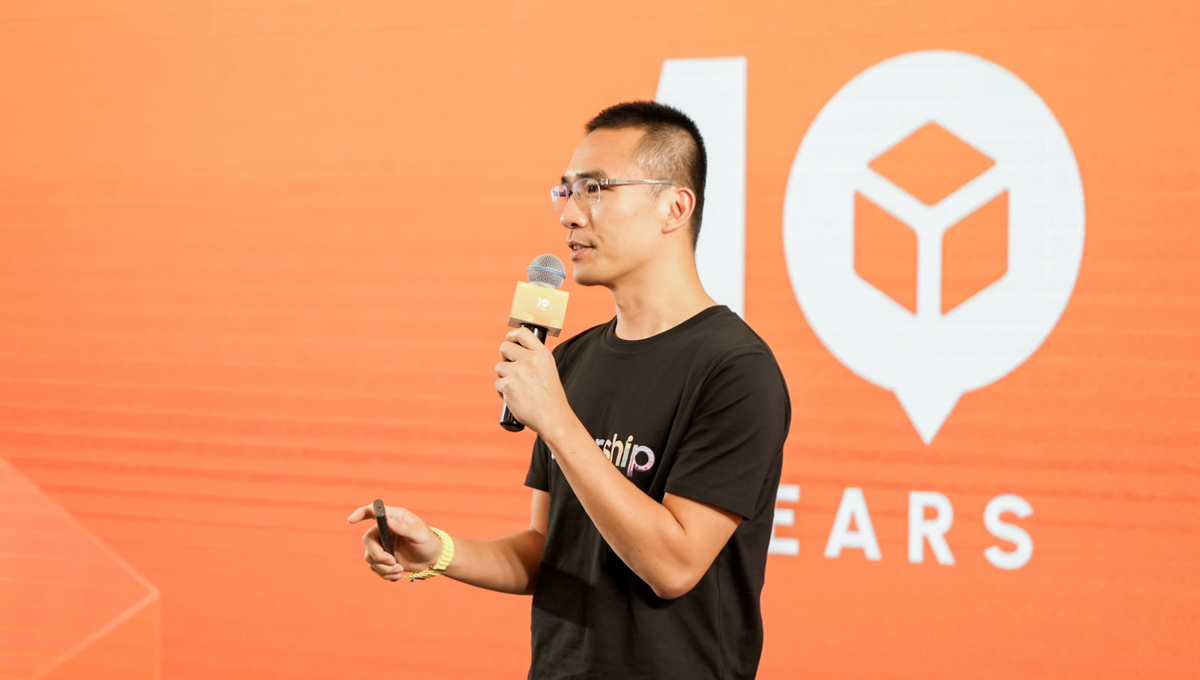
Hello and welcome, and thank you all for listening today to my AfterShip 10-year anniversary speech. I’m Teddy Chan, the CEO and co-founder of AfterShip.
Before I start the main part of today’s speech, I hope you won’t mind if I briefly introduce myself.
I’m a really average guy. Growing up, my family was poor. And after I graduated from high school, I didn’t get into a big-name university.
I’ve always envied people who can write music and lyrics, or who can write great articles. Those kinds of people always get described as talented.
But I knew I didn’t have much talent for music. And the articles I wrote never won any praise from my teachers.
I often think that if I wasn’t a CEO, then I would like to be a software engineer forever.
That’s because I really like writing code. When I write code, I can create something in a virtual world which perfectly expresses my ideas and vision.
So, the story I’ll tell you today is the story of a software engineer turned entrepreneur.
It’s also a story of how I came to understand that entrepreneurship is a path that requires winning trust and creating value.
1. AfterShip started as a solution to challenges I was facing at the time
I’ve been an entrepreneur since 2004. After I graduated from university, I went straight into international eCommerce.
My main business was selling electronic products such as MP3 players. I’d source them from Huaqiangbei in Shenzhen and sell them internationally.
At that time, I rented a small room in Huaqiangbei. I used that room partly as a storeroom, and partly as an office.
I was receiving over one thousand customer emails each day, asking questions such as:
“Has my order been sent yet?”
or
“Where is my order?”
To deal with this problem, I hired several people whose main responsibility was dealing with these emails.
But as our operations continued to grow, emails continued to come in much faster than we could answer them. This made us feel as if we were an email response machine, mindlessly replying to emails as fast as we could.
This situation also meant I couldn’t help but start to think about this question:
If, with 2,000 orders every day, I need to hire 10 people to answer emails, what will happen if the order amount grows again several times over? Will I need to hire dozens, or even hundreds of people just to answer emails?
It became clear that answering all these emails was a repetitive task that didn’t create value. Working in this way really didn’t fit my values as a software engineer.
As a software engineer, I hope to be able to resolve problems by automating them or by using technological solutions. That way, time can be spent on things which have more value, rather than on repeatedly completing the same daily tasks.
I started categorizing the emails we received. I found that most emails were asking about the progress of shipment deliveries, so I wrote a program that could automatically track shipments and that would notify customers of shipment progress without us having to do anything.
That simple program allowed us to reduce the number of customer emails we needed to respond to by 60%. And that simple program was what later became AfterShip.
As I started my eCommerce business in 2004, I was one of the earlier international eCommerce sellers. The profit the business made wasn’t bad at all for someone who had just graduated from university.
In those early days, I spent two years working almost every day to make money. Most weeks, there would be two days when I worked right through the night.
After working for two years like that, my body felt ready to give up. At that time, I even sometimes felt like I might die.
So I couldn’t help but start to think:
“If I really did die now, then apart from having earned a bit of money, what would I have contributed to this world?”
And that made me realize, it seemed as if I hadn’t contributed anything at all.
To put it even more harshly: My business was just selling and buying. Buying for a low price, selling for a higher price. I didn’t even have my own brand and I wasn’t creating any value.
This made me want to create a software company, to create a product that could really create value for customers.
2. It took me five years (and a bit of luck) to find the right business partners and start AfterShip
The first step to founding a company is finding the right business partners.
So from 2006 to 2011, I was constantly looking for business partners. I looked everywhere, from former classmates to people I had met through my work. I also went to all kinds of social and networking events.
At the start, I thought that the world would be full of many other people with similar ambitions to me and on similar paths. But when I told people about my ideas, I was rejected by one person after another. They all said that what I wanted to do was too unrealistic.
This made me feel extremely lonely.
My wife even sometimes joked with me, saying:
“You can’t find business partners because we are all from Earth and you are from Mars. Your thinking is not the same as other people’s.”

This went on until one day in 2011. I went to an event recommended by a friend of mine, and when I got there, I found it was a startup competition.
I thought I had to buy a ticket to enter, but I was told I needed to come up with an idea and do something called “pitching.” This was the first time I had heard the word “pitching,” and I had no idea what it meant.
I asked the workers at the event if they could explain. I was told I needed to make a speech about my idea in front of everyone, and persuade other people to vote for me. Then I would see how many people liked my idea and wanted to join my team.
And when I heard other people talk about their ideas, I was surprised and happy to discover that these people weren’t from Earth like most people. They were “martians” just like me!
This discovery made me really excited. Before that, I had thought I was the only person on earth who thought the way I did. But that day I found so many people who had similar thoughts and ideas.
Yet compared with all the colorful and imaginative ideas they were talking about, for me to talk about “software that automatically tracks shipments” seemed a little dull and bland.
So, in the end, our team had the fewest members. The other teams all had ten or more people. Our team had three people.
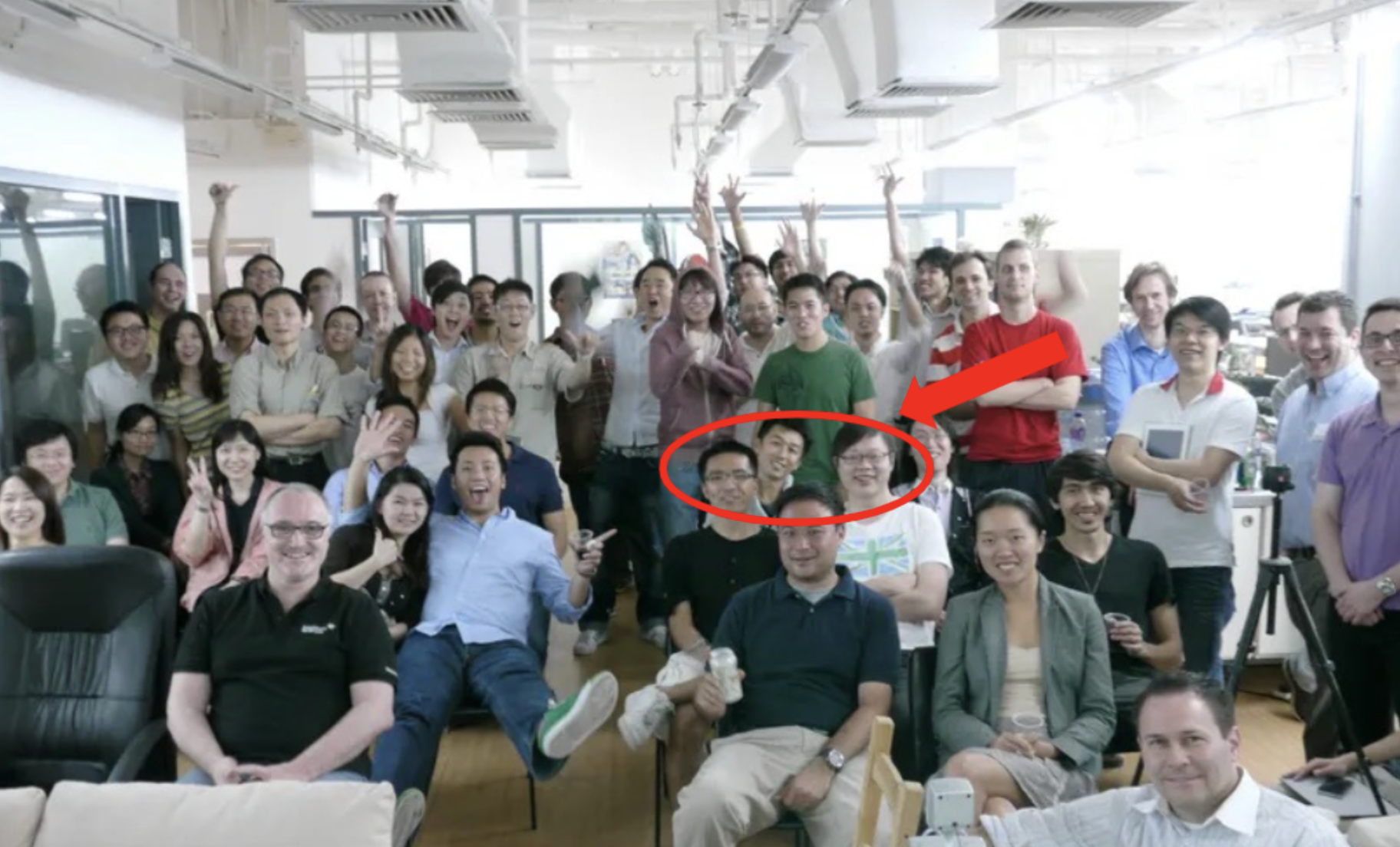
At the start, we thought it was a weakness to only have a few people. But after we actually started working on our product, we found that as long as you’re working with the right people, a small team is actually better than a large team.
Perhaps for the larger teams, it may have taken them a while to reach a consensus on product direction or division of labor. But with our smaller team, we found that we could reach an agreement very quickly, which gave us more time to focus on our actual work.
Even though our team had the fewest people, we were able to produce our product very quickly. In the end, we won that startup competition.
This led me to start to believe:
A great team with an average idea is far better than an average team with a great idea.
But winning wasn’t the most important thing I gained from joining that startup competition.
From my point of view, the most important thing I gained from joining that startup competition was meeting Andrew. After five long years, I finally found the business partner I had been looking for.
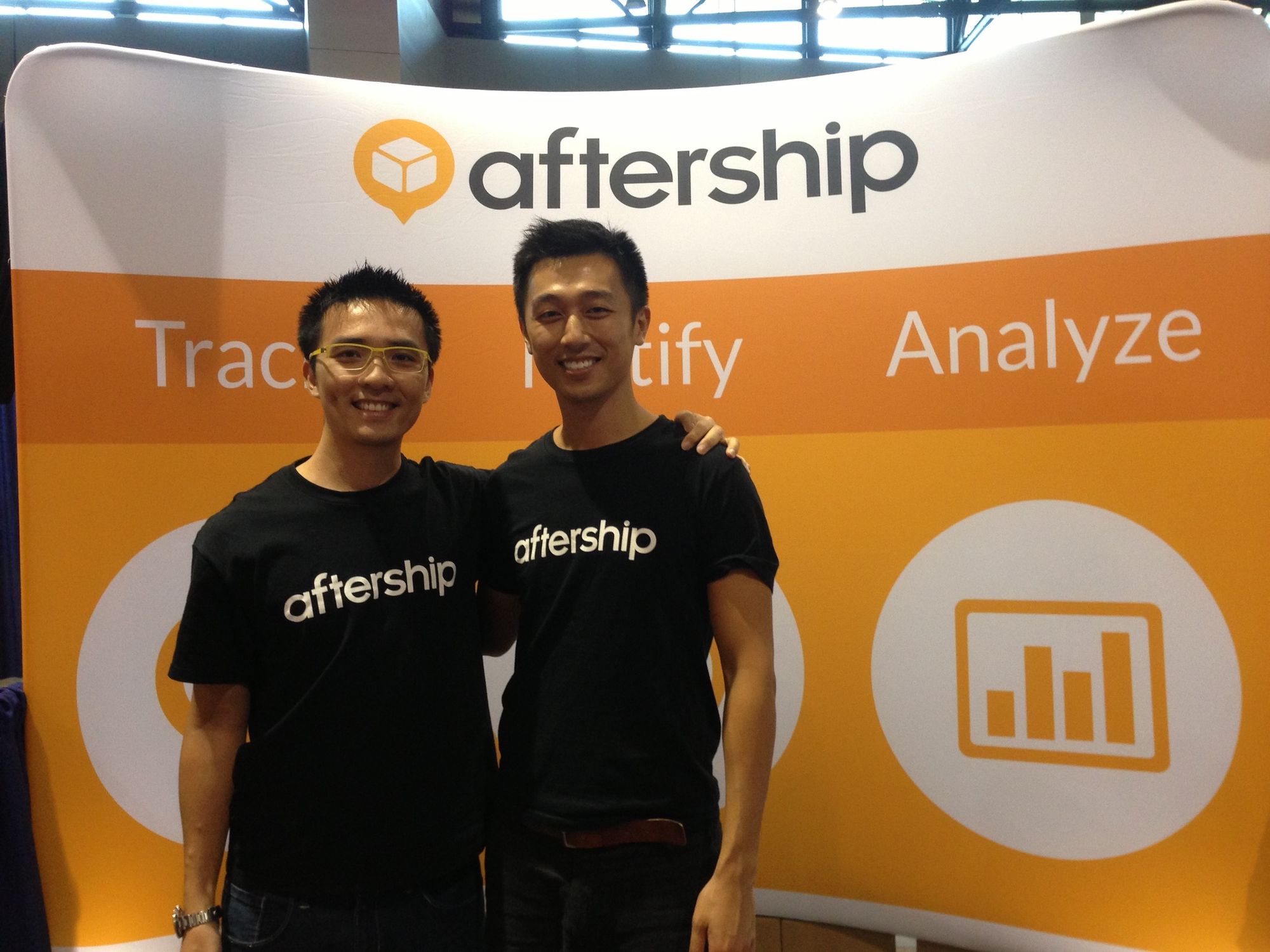
After that, we founded AfterShip together.
3. We listened closely to our customers needs, and yet our company logo contained a huge mistake
One of the first things you do when founding a company is to confirm the company name and logo.
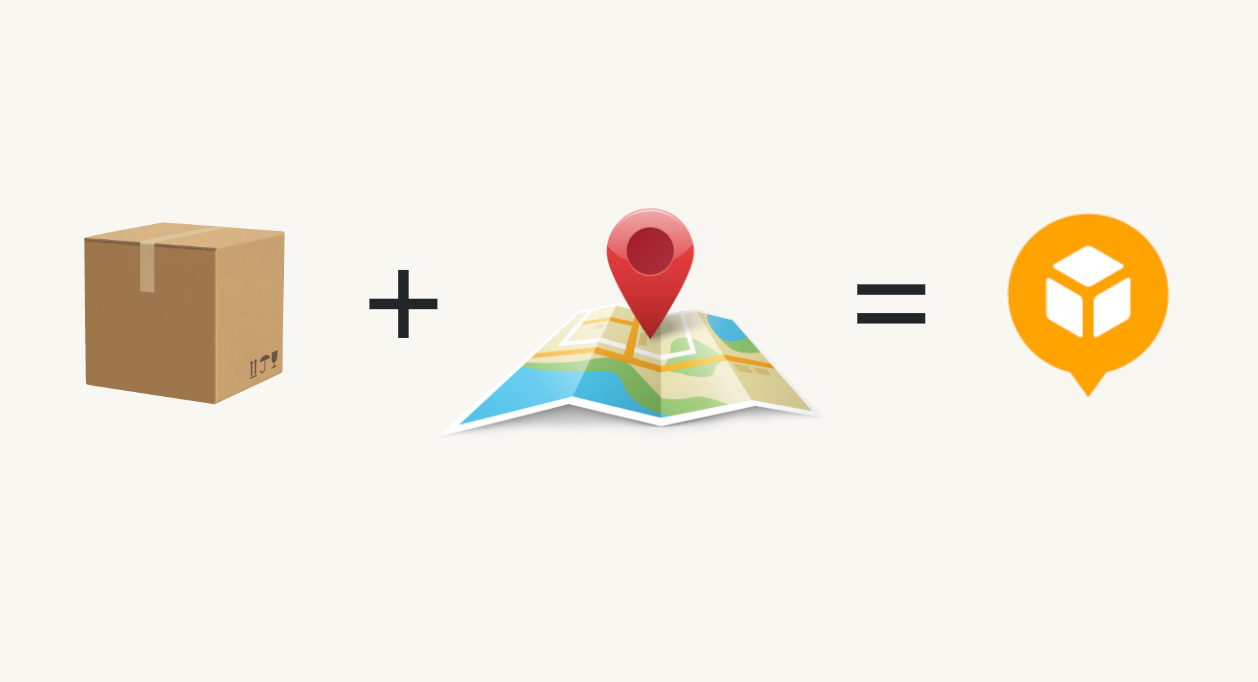
As customers were asking us “where is my order” every day, when we designed our logo, we placed a package in the center, on top of a map location pointer.
At the time, we were really happy with that logo. We assumed that when customers asked us “where is my order,” they really cared about exactly where their order was physically located. We even created a map display feature to show customers where their shipments were.
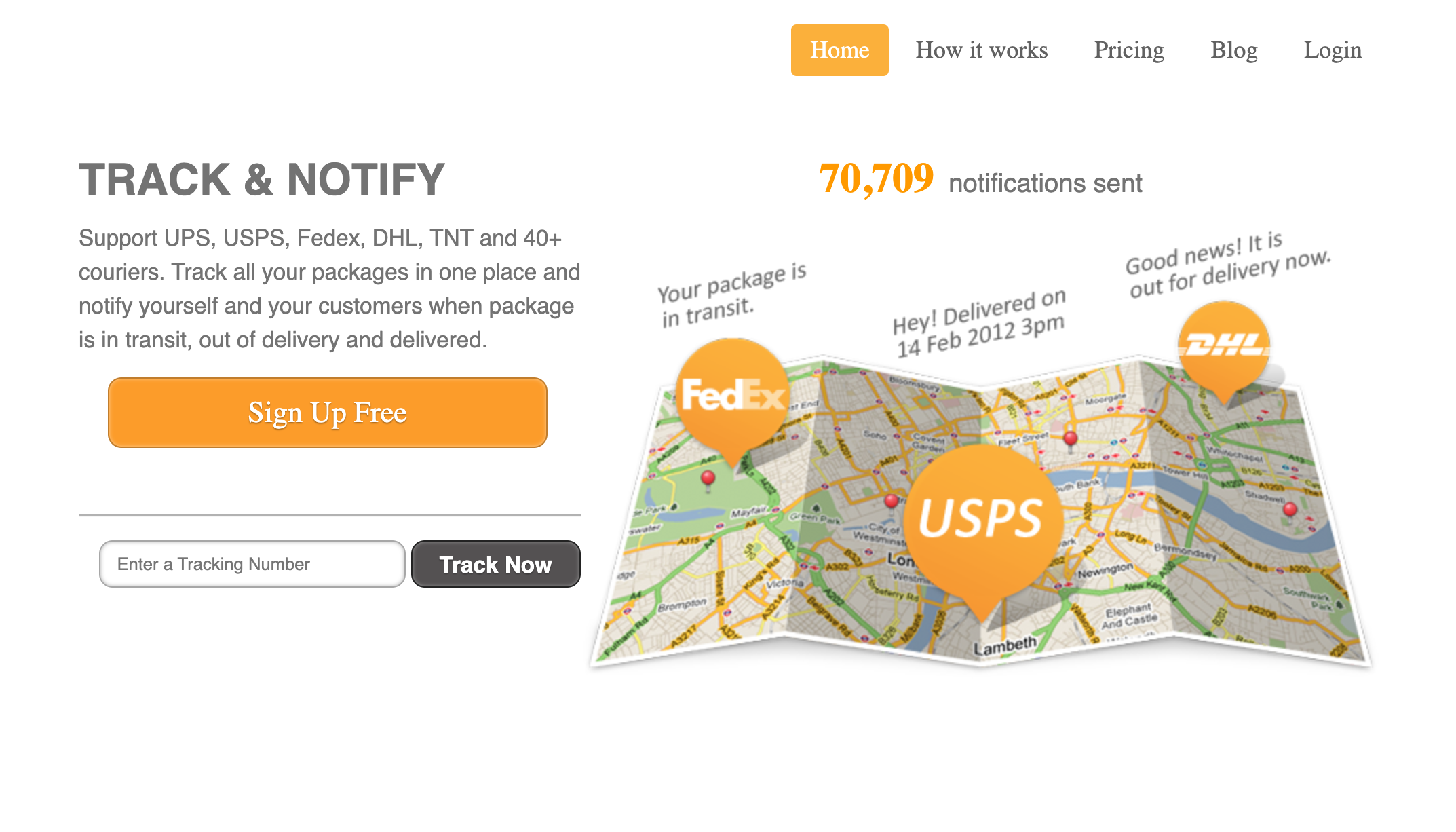
We thought that this feature could surely provide our customers with all the answers they needed about where their shipments were.
But later we discovered that even with this feature, there would still be some customers asking about the progress of their order deliveries.
This went on until one day I realized we had made a huge mistake:
What the customer really cares about isn’t “Where is my order?”, but rather “When will I receive my order?”
As a result, we quickly adjusted our direction. We removed the map function and replaced it with a function that shows expected delivery dates. But we’ve continued to use this logo up till today to remind us of this key principle:
What the customer says they need may not be the same as their actual needs. We need to think deeply to figure out what the customer’s real needs are.
4. No matter how good a product is, there’s still no guarantee it will win the customer’s trust
Soon after we put our product online, we were very lucky to have customers who were willing to pay us for it. There was even one very large platform customer, who actively sought us out and said they wanted to use our services.
At that time their team was in India, so Andrew went to India specifically to discuss cooperation with them. They really appreciated the value our product could bring them, so it looked as if everything would go smoothly.
But in the end, Andrew told me that the customer had said they didn’t want to work with us.
The reason they gave at the time left a deep impression on us:
“Your product is excellent, but your team members don’t have outstanding resumes and you’re not backed by any well-known investors. So we’re afraid you might go out of business.”
Or to put it simply: They didn’t trust us.
I certainly don’t think this customer was wrong. Thinking about risk management is necessary for most large companies.
But this experience taught Andrew and me a lesson we would always remember. In B2B SaaS, we not only need to make products which create value for the customer, we also need to figure out ways to win the customer’s trust.
So, we decided to secure a round of funding as quickly as we could. It didn’t matter to us whether it was for a large or a small amount of money. What did matter to us was that it was from a well-known investment company.
Just at that time, we were approached by IDG Capital. We spent about an hour in discussion with them and quickly received one million US dollars in Series A funding from IDG Capital, and this funding round was reported on media platforms like TechCrunch.
After that, many large customers who appreciated the value of our product started cooperating with us. Those customers included eBay, Wish, IKEA, and more.
As of our tenth anniversary, we provide services to more than 14,000 paying customers globally. We’ve tracked a total of more than 4.4 billion shipments. And more than one billion of those shipments were tracked in 2021 alone.
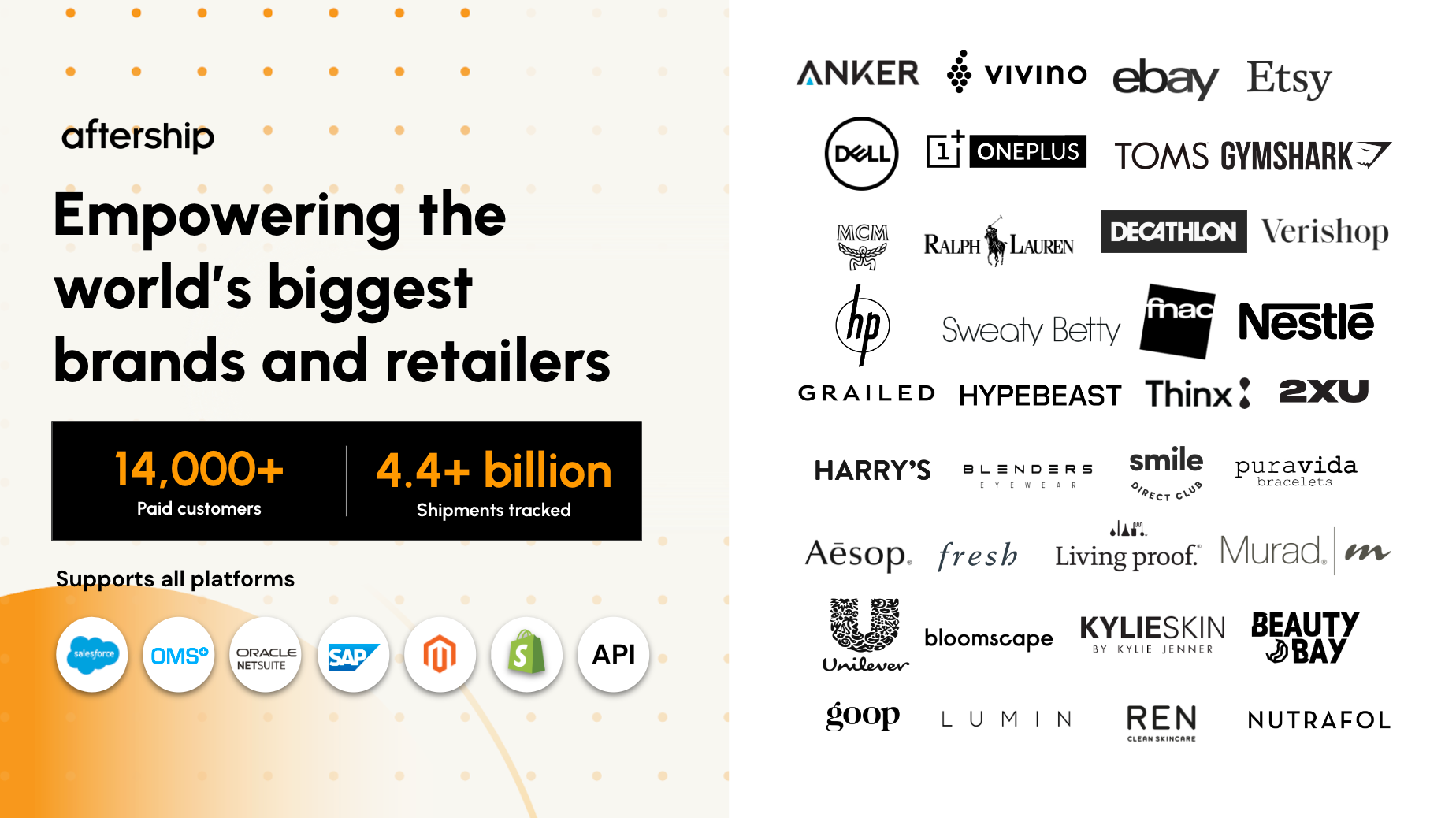
Even more importantly, right up to today AfterShip has continued to create value for our customers and to grow together with them. We’ve seen many of our customers become publicly listed companies.
5. Unable to complete hiring goals, I went to wherever the talent was
In 2014, backed by our successful funding round, we found that gaining customers was no longer a problem.
At the time we had built our team in Hong Kong and recruited people from all over the world to work together. Even then, when our team only consisted of about 20 or so members, our members came from more than 10 countries and regions.
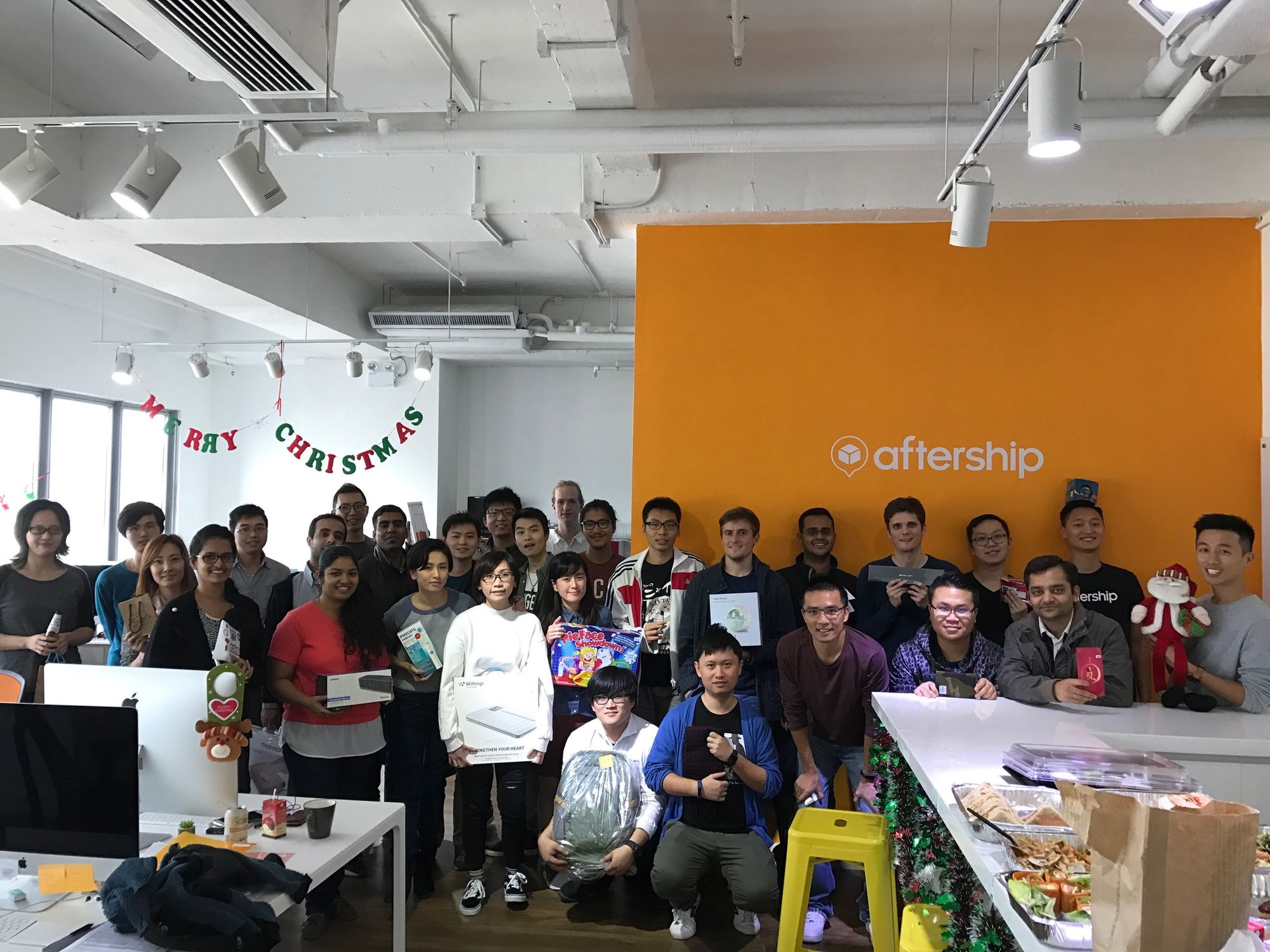
But as the company operations continued to expand, we found ourselves facing a new problem:
We couldn’t find enough talented people to support the needs of our customers.
Every year in Hong Kong, there are only several hundred people who graduate with an IT-related major. To hire these graduates, we had to compete with many other companies. So by 2016, we still hadn’t hired many new team members. We also weren’t making much progress towards our software development goals.
In addition to that, our customer operations were constantly increasing, as were the expectations of our customers. We had no way of building a customer service team in Hong Kong that could support the needs of our global operations.
So in 2016, we decided to change our strategy:
Rather than continuing to hire global talent in just one location, we decided that wherever the talent was, we would go there too.
Once we’d made that decision, we visited many countries. In the end, we decided to build our customer service team in India and build our R&D team in the Asia-Pacific region.
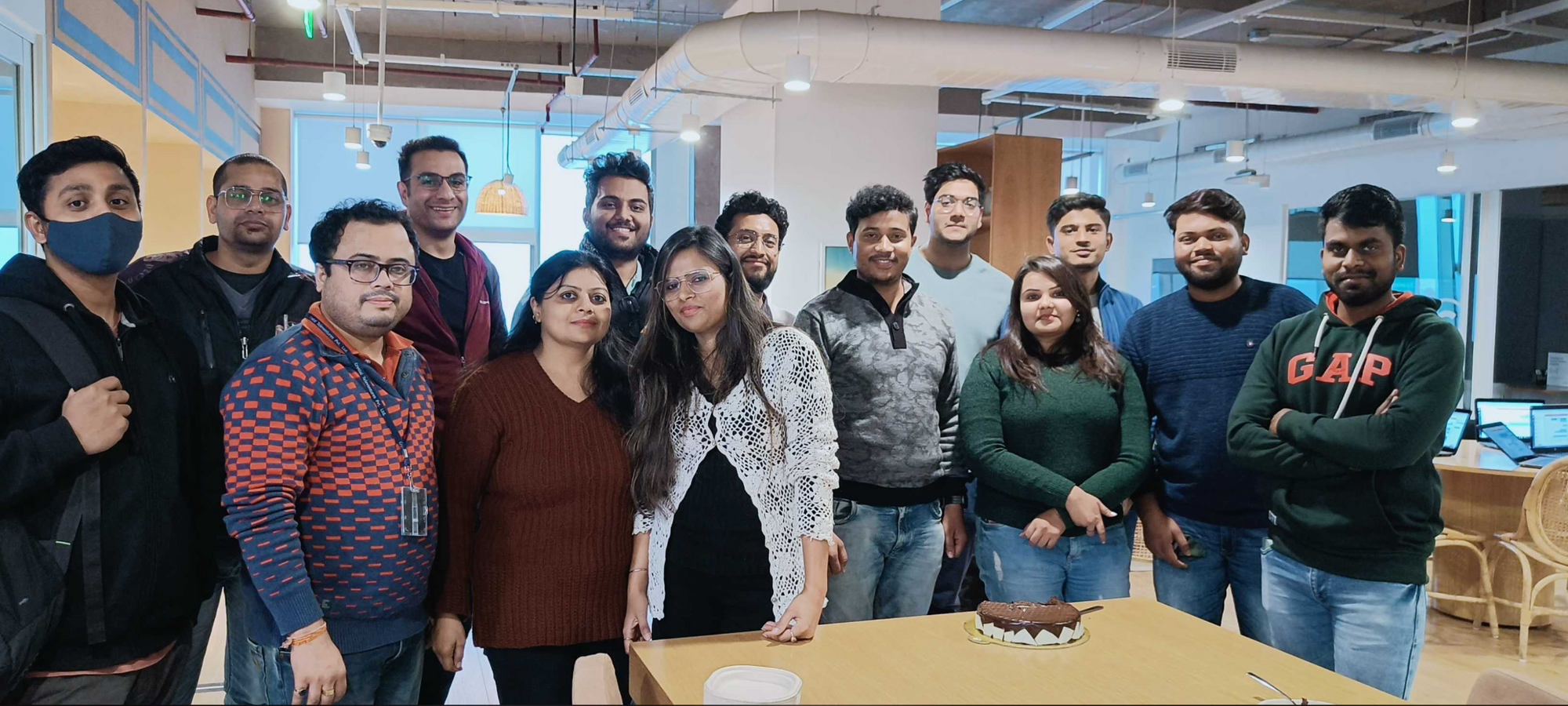
6. It’s better to let talent find you than to go searching for talent
2020 was a year when international eCommerce growth really took off. It was almost as if we could do in one year what would have taken several years before.
At that time, even though we had over 100 people on our APAC R&D, it still wasn’t enough to keep up with the speed at which our operations were expanding, so we needed to keep on growing our team.
When our company size was between one and 100 people, it was possible for me to participate fully in every interview, communicate with the candidates, and find the right people to join AfterShip.
But with 100 to 300 people in the company, it became much harder for me to participate in every interview. Besides, if we wanted to find 300 people really well-suited to working at AfterShip, we would need to get the word out so more and more people would know what AfterShip was.
When I was thinking about this problem I thought of a method a good friend had shared with me:
“Rather than going out to find people, you should let people find you. Writing is a great way to influence more people.”
That’s why I decided to write my SaaS 102 article series, to help more people understand the SaaS industry and the ideas behind how AfterShip does business.
Once I started this project I found out that it was like recruiting people. There are no shortcuts. You can only take it slowly and write one article after another.
After two years, I’ve now written 38 articles. The account where I publish these articles started out with zero followers. It now has more than 6,600.
I know that 6,600 is a very low number. But I think quality is more important than quantity.
After all, my goal isn’t to write hugely popular articles. It's to find people who share our goals and aspirations to join us on our journey.
That’s why I’m very happy to share the following fact with everyone: Since AfterShip surpassed a team size of more than 100 team members until now, 60% of new hires had read SaaS 102 before they joined us.
As well as writing articles, we also secured a Series B funding round led by Tiger Global in April 2021.
This led even more customers and candidates to believe more firmly that what AfterShip does has value. Going forward after the funding round, more candidates believing in us means we can better expand our international team.
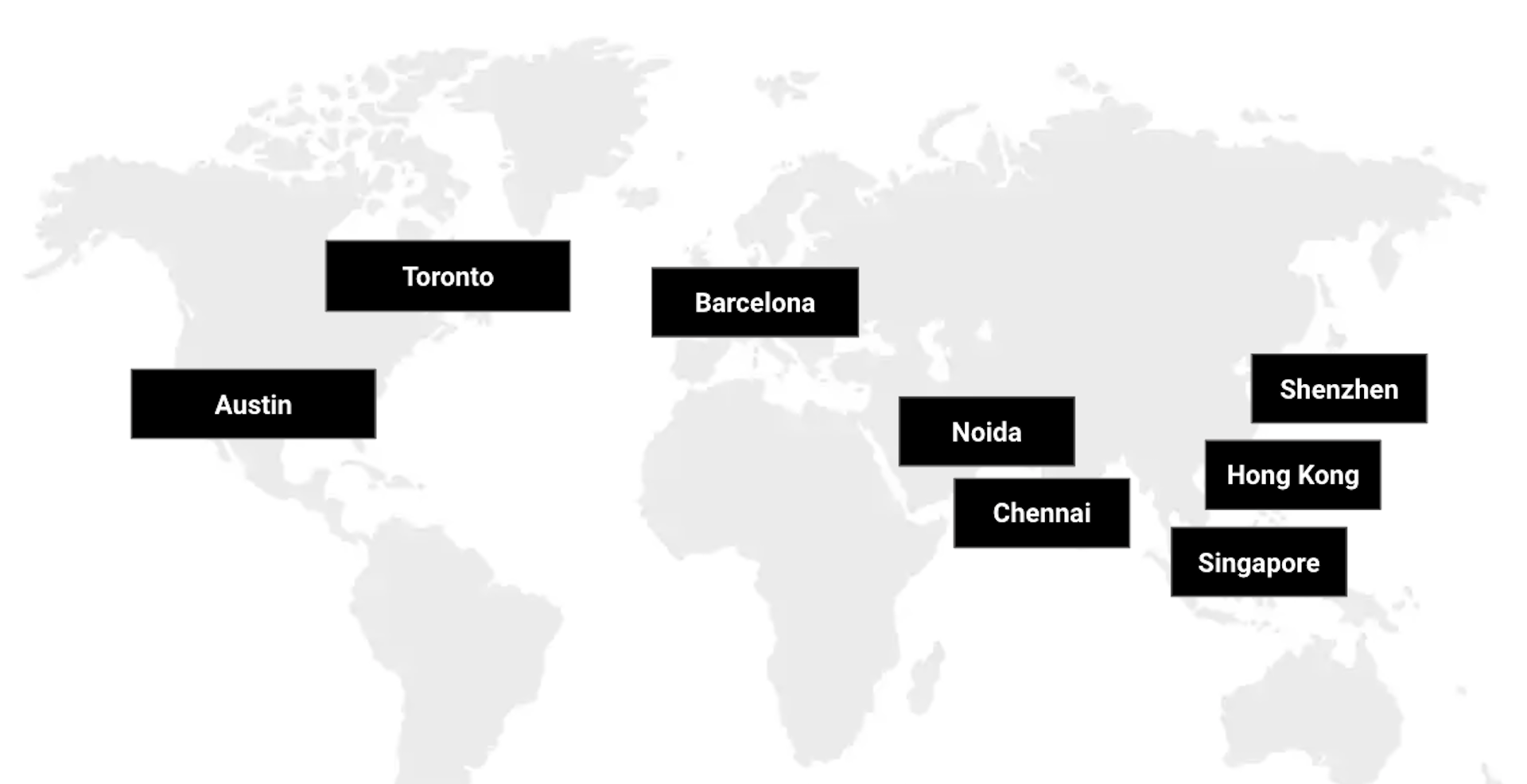
As of now, we already have eight independent office locations across the world, and our team has expanded to more than 400 people.
7. Finding talented people is just the first step, the next step is to grow and develop together with them
Hiring outstanding people is just the first step. After we hire people, we still have to do everything we can to allow everyone in our company to grow and develop as well as possible.
That’s why I’ve put the following four things into action:
First, as much as possible, we put the money we make back into our products and team.
I know there’s a joke that goes around at workplaces:
“If you just work hard this year, next year your boss will be able to buy a new Lamborghini.”
But I don’t want people on my team to think they are working just for me. I want people in my company to know that they are working hard for themselves, that they are earning money for themselves.
That’s why even up till today, I put all the money the company has earned back towards our products and our team. This has helped us to make our products better and gone towards pay raises and benefits.
I’m aware that many people from outside our company might think we have a great office space.
But we only got the office we have today through a gradual, step-by-step process. And we wouldn’t have it at all if not for the hard work of everyone in our company.
Our office version 1.0 was just a small storeroom. But with our hard work and the money we made, we upgraded step-by-step until we entered our office version 5.0: the four-floor, 8,000-square-meter space we have today.
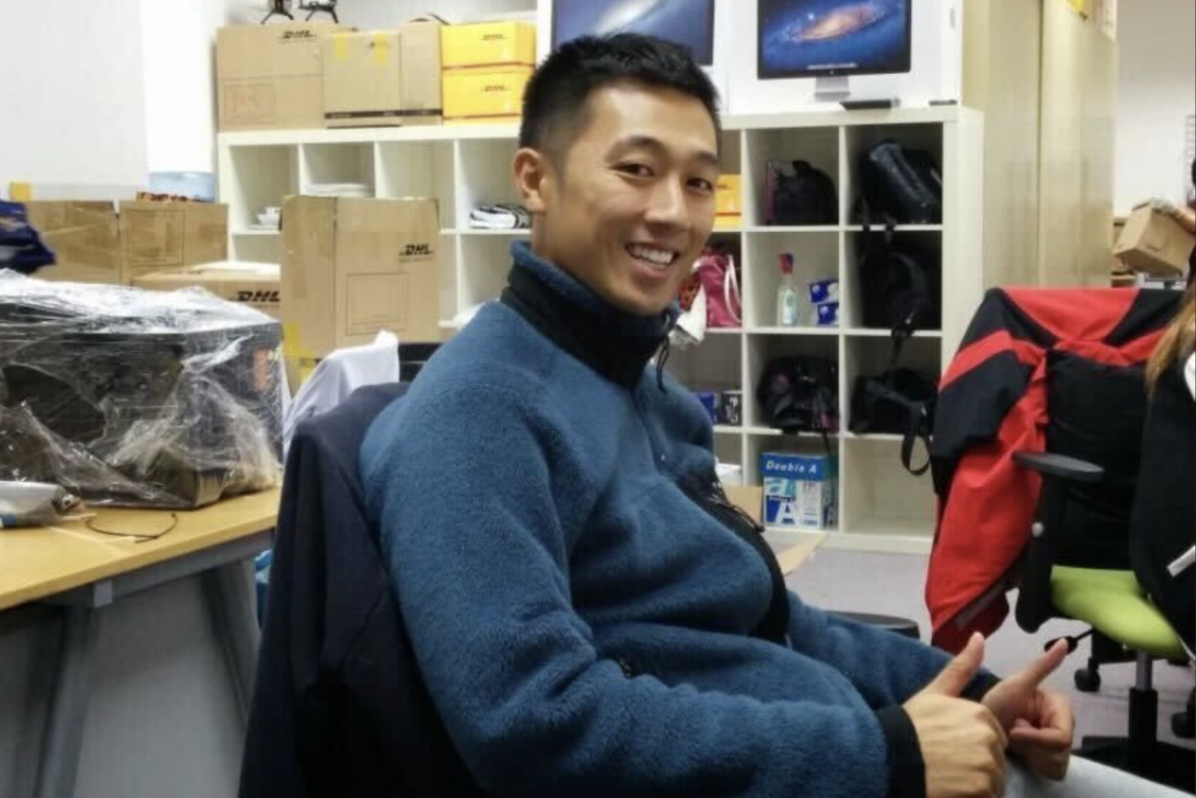
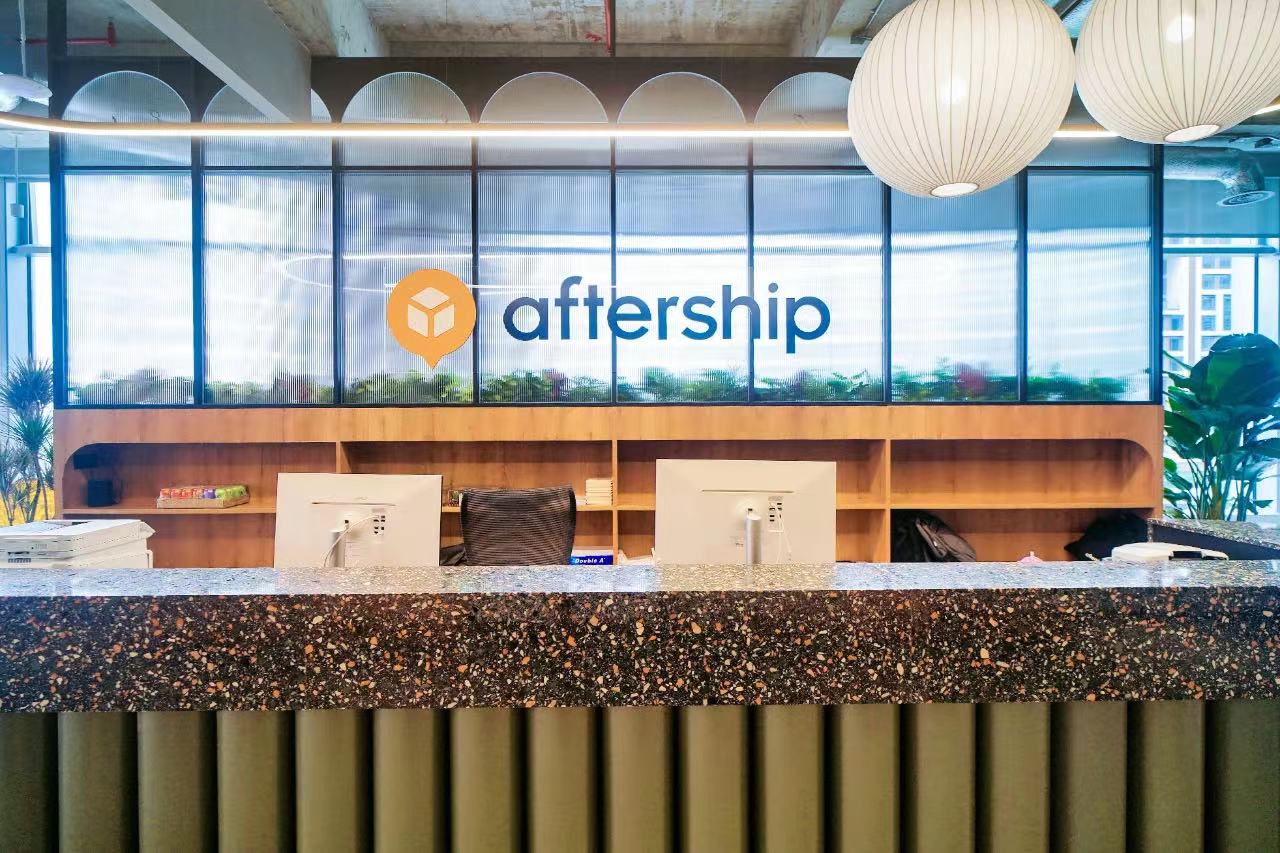
As long as we can keep our feet on the ground, create value for our customers, and create revenue for our company, we will be able to obtain better benefits and salaries for ourselves.
Second, we continually hire outstanding people, so that everyone can grow together.
Previously, when I was in eCommerce, Amazon had a very large influence on me. So I studied their Bar Raiser program.
When we hire new team members, we will only consider a candidate if they are above the average level of our current team members.
We follow this policy because we believe that the best benefit a company can offer a person is the opportunity to work together with other, even more outstanding people.
Only if the people around us are outstanding will we have the chance to learn from them and to grow and develop even faster.
And only if every person on our team is growing and developing will we be able to create more value for our customers, and more revenue and benefits for ourselves.
Third, we protected the company’s principles and culture.
One rule that helps to protect our company culture is: during the hiring, training, and employment process, our company values alone are always reason enough not to hire, or continue to employ, a candidate or employee.
If a person doesn’t match our company values, then no matter how outstanding they are or how high-level they are, we should not let them join us and stay at our company. Even for me, if one day I change to the extent that I no longer match the company values, everyone should tell me to leave.
Another rule we operate by that helps protect our company culture is that we don’t sign contracts with customers that last longer than one year.
SaaS stands for Software as a Service. Essentially, we sell services, not products.
So in order to guarantee we can continually sell the best services to our customers, we won’t sign customer contracts that are longer than one year unless the customer expressly requires it.
I hope that this rule can help us make sure that we don’t hold our customers “captive” with multi-year contracts that they cannot escape from.
If customers only sign a one-year contract, then in order to make sure they renew their contract, the only thing we can do is provide them with the best services possible.
So I hope that by not signing contracts longer than a year, each one of our employees will realize that we have to honestly and thoroughly manage and control each and every stage of our company operations. We need to hire the right people, create great products, sell our products to the right customers, and work hard to provide customers with great service that comes right from the heart.
Fourth, we faced mistakes together with the team and accepted responsibility for results.
Although it’s already been 10 years since we founded AfterShip, we are still a startup company. We’ve made a lot of mistakes, and some of those mistakes have been very costly.
I remember a day when I received a call from the salesperson for our cloud service provider. He asked us whether our business had been much better recently.
I thought this was a strange thing to ask, so I asked him what he meant by “much better.”
He said that he’d noticed that we had a service for which usage volume had exploded. In just one day, we’d spent 160,000 US dollars on that service.
When I heard this, I didn’t really take it in at first. My mind was struggling to adjust to the idea of how much money 160,000 US dollars really was.
After a couple of seconds, it hit me. That was a lot of money!
That gave me a fright. I quickly called James, our CTO, to see what had gone wrong.
Our team quickly found out the cause of the problem. One of our engineers had accidentally written an infinite loop into our code, which caused it to write a huge amount of logs at high speed.
Luckily, our team fixed this problem quickly. Otherwise we might have continued to lose a lot of money every day.
If you were a CEO, and something like this happened at your company, how would you deal with it?
Our response was:
- We put together an incident review of how the mistake happened, and shared it with our team as a warning.
- We checked and optimized our process for reviewing and deploying code, in order to prevent similar mistakes from happening again.
And today, the engineer behind that error is still working with us and creating value for our customers.
I know at this point some people will be asking: “Then who took responsibility for that mistake?”
I would bet that the vast majority of companies don’t have predefined rules for how to deal with a situation such as this. We also didn’t have any rules for this kind of situation.
That made this situation a character-testing moment, as well as a test of our company values.
One of our company values is to “Keep It Simple.” Specifically, this value requires us to “adhere to a flat organizational structure, keeping our communications simple and straightforward.”
So we asked: “Did this engineer create the infinite loop deliberately?”
We believed that the engineer didn’t create the infinite loop deliberately.
Besides, in the postmortem we found that this wasn’t a mistake caused by just one person. All of our code goes through a code review process. Our system also had fault monitoring in place.
But as our processes weren't good enough, we were unable to catch this edge case and prevent this incident from happening.
So if someone was responsible for this mistake, then we were all responsible for this mistake.
Our company culture also requires us to embrace a “geeky spirit.” Our description of what this geeky spirit looks like is:
“We are curious and passionate about what we do. We thrive when we are continuously raising the bar for ourselves and our team.”
So we chose to find and resolve the root cause of the problem. We made extensive refinements and changes to our internal processes, rather than trying to solve the problem by blaming one person for the mistake.
After we made those changes, we haven’t had any similar incidents.
To a certain extent, having that incident happen at that time was a good thing. Because if the same mistake were to happen again today, I think that our losses would be much more than 160,000 US dollars.
8. What are AfterShip’s goals for the next ten years?
After hearing about us losing money, many people will definitely be curious about how our business is doing now.
If you compare us to the best companies out there, there are definitely many areas our company still needs to improve in. But from a growth perspective, in the past few years our ARR growth rate has stayed above 100%.
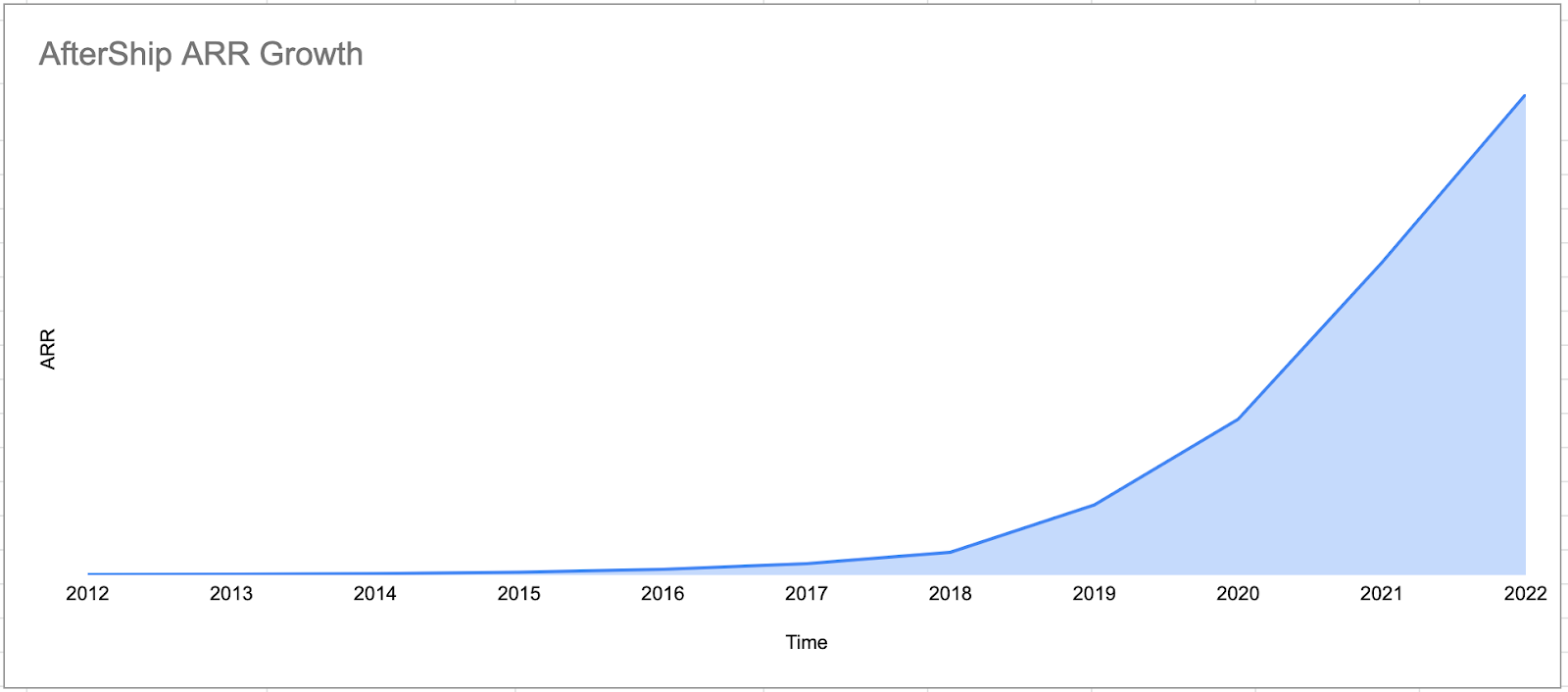
After seeing this graph, at least two people on our team asked:
“Is there a problem with the figures in this graph? How is it that our company had almost no revenue for the first few years?”
This is something that I want to say to everyone:
SaaS is a fundamentally long-term endeavor. It’s very normal for the numbers to be very low for the first seven or eight years.
This also applies to the ARR of SaaS companies that are now publicly listed. In their early stages, they had numbers so low you could hardly see them. In later stages, they started to see exponential growth due to the compounding effect.
So, it has been very difficult for our company to survive up until this point. We’re also very grateful for all the hard work our team has done over the past few years.
And today, AfterShip is finally 10 years old. Many people want to ask us: “What are our goals for the next ten years?”
I’d like to share some of my experiences to help you all understand my answer to this question.
Whenever I go to other countries and explore different cities for travel or business, I notice that among all the brands lit up on the big digital billboards, very few are our customers.
The first group of customers for our products was made up of small customers. Very few of them could have afforded those big advertising spaces.
But over the last two years, as we’ve been expanding our team globally, I’ve found that of the big brands I see on the billboards, more and more have become our customers.
I’ve even found that sometimes when my wife buys something online, after the package arrives at our home, my kids ask:
“Daddy, isn’t this brand one of your customers?”
I then quickly go and check the back-end and find that the brand actually is one of our customers. I can then proudly reply:
“Yes, yes they are.”
That sense of achievement is so much better than what I used to feel when I was just buying and selling goods to earn money.
So, I’ll share with everyone here, the goal for AfterShip over the next ten years is:
We want to start providing services for more than half of the world’s eCommerce brands.
That way, when you visit any famous city, you can proudly say to your friends and family beside you:
“You see the brand names up on those billboards? More than half of them are our company’s customers.”
9. Entrepreneurship is a path that requires winning trust and creating value
I’d like to wrap things up with a simple story.

A very long time ago, three teams wanted to cross a desert. The first team that arrived at the destination would be the winner.
In terms of physical ability, number of members, and supplies, the teams were roughly equal. The teams also knew the correct direction.
But the first team didn’t have watches, and didn’t have a clear destination as a target. They just knew they had to walk forwards.
The second team had watches, but didn’t have a clear destination as a target.
The third team had watches and had a clear destination as a target.
Which team do you think has the best chance of reaching the destination?
The answer is the third team.
Right now, we are actually in the same position as the third team.
We have a clear destination. Our destination is for over half of eCommerce brands to use AfterShip’s services.
We are clear that what we want to do is a long-term endeavor. It may take us 20 years to succeed. We have watches, and we have just finished the first 10 years of our journey.
So, we have everything we need to get to our destination. Even more importantly:
We have finally found team members, cooperation partners, and investors that are willing to trust and believe in us and to focus on long-term value.
Over the past 10 years, perhaps it has been up to Andrew, James, and myself to drive the company forward.
But over the next ten years, I hope that everyone on our team will drive the company forward. It is you, our team members, that are closest to our customers. You are outstanding, talented professionals with expert knowledge in your fields.
Entrepreneurship is a path that requires winning trust and creating value. Let’s set out again together, and see what the next ten years will bring.
